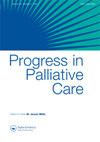为患有限制生命的神经发育障碍的年轻人过渡到成人服务:一个案例系列
IF 0.9
Q4 PUBLIC, ENVIRONMENTAL & OCCUPATIONAL HEALTH
引用次数: 1
摘要
由于医疗保健的进步,越来越多患有限制生命的神经发育障碍(LLNDD)的年轻人现在能够活到成年。然而,儿科和成人医学之间的传统护理模式是分散的,不符合他们的多方面需求。成立了一个由儿科医生、成人姑息治疗团队和非政府组织代表组成的特别工作组,在过渡到成人姑息治疗小组之前提供12-24个月的联合护理。介绍了2015年7月至2020年6月期间在研究机构记录的19名患有LLNDD的年轻人的回顾性病例系列。招募的患者年龄在18-38岁之间(平均26.2[SD6.1]) = 14) 需要长期护理机构(LTCF)的住院护理和高水平的护理,包括人工营养(n = 8) 和家用呼吸机(n = 5) 。所有转诊到我们姑息治疗(PC)项目的患者都参与了结构化的预先护理计划(ACP)过程。17名患者(89.5%)制定了“请勿复苏”(DNR)指令,两名精神健全的患者完成了自己的预先指令(AD)。所有死者(n = 10) 他们的DNR指令得到了遵守。总之,应适当解决患有LLNDD的年轻人的姑息治疗需求,在儿科和成人PC团队之间实施联合过渡护理模式是一种可能的方法。未来的研究应该包括一种更好的护理模式,以满足患有LLNDD的年轻人的多方面需求,特别是从儿科向成人医学的过渡。本文章由计算机程序翻译,如有差异,请以英文原文为准。
Transition to adult services for young people suffering from life-limiting neurodevelopmental disabilities: A case series
Due to advances in medical care, a growing number of young people with life-limiting neurodevelopmental disabilities (LLNDDs) are now surviving into adulthood. However, the traditional model of care between pediatrics and adult medicine was fragmented and did not match their multi-facet needs. A special working group that includes pediatricians, adult palliative care team, and representatives from non-governmental organizations (NGOs) was formed, providing a period of joint care of 12–24 months before transitioning to the adult palliative care team. A retrospective case series of 19 young adults with LLNDDs, recorded during the July 2015–June 2020 period at the study institution is presented. Recruited patients’ age ranged from 18 to 38 (mean 26.2 [SD 6.1]). Majority of them (n = 14) require residential care at long-term care facilities (LTCFs) and high level of nursing care, which include artificial nutrition (n = 8) and home ventilator (n = 5). All patients referred to our palliative care (PC) program were engaged in a structured advance care planning (ACP) process. Seventeen patients (89.5%) had their Do-Not-Resuscitate (DNR) directives in place and two mentally competent patients completed their own advance directive (AD). All deceased (n = 10) had their DNR directives being honored. In conclusion, the palliative care needs of young adults suffering from LLNDDs should be properly addressed and implementation of a joint transitional care model between pediatrics and adult PC team is one possible method. Future research should encompass a better care model that addresses the multi-facet needs of young people suffering from LLNDDs, especially the transition from pediatrics to adult medicine.
求助全文
通过发布文献求助,成功后即可免费获取论文全文。
去求助
来源期刊

PROGRESS IN PALLIATIVE CARE
PUBLIC, ENVIRONMENTAL & OCCUPATIONAL HEALTH-
CiteScore
2.60
自引率
11.80%
发文量
24
期刊介绍:
Progress in Palliative Care is a peer reviewed, multidisciplinary journal with an international perspective. It provides a central point of reference for all members of the palliative care community: medical consultants, nurses, hospital support teams, home care teams, hospice directors and administrators, pain centre staff, social workers, chaplains, counsellors, information staff, paramedical staff and self-help groups. The emphasis of the journal is on the rapid exchange of information amongst those working in palliative care. Progress in Palliative Care embraces all aspects of the management of the problems of end-stage disease.
 求助内容:
求助内容: 应助结果提醒方式:
应助结果提醒方式:


